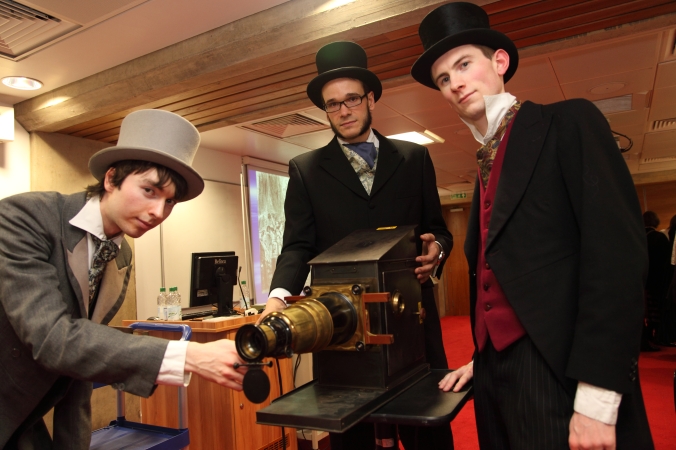Conversations on Nature at the University of Leicester Library
If you were a member of 'genteel' Victorian society, a 'conversazione' may very well have been the highlight of your social calendar. Dressed in your finest, you would have proceeded to the nearest public hall to enjoy polite conversation and learned lectures on all branches of the arts and particularly the sciences. An array of exciting and interesting objects, such as fossils or microscopes, would be arranged on tables for your inspection. Practitioners of science would be on hand to explain the latest theories and experiments, perhaps with the aid of a 'magic lantern', an image projector powered by a (worryingly volatile) oxy-hydrogen flame or 'limelight'. It was an opportunity to see and be seen, in addition to keeping abreast of cutting-edge research. An illustration by Richard Doyle, published in an 1862 issue of the Cornhill Magazine, perfectly captures such an event in progress.

It was this picture we took as a template for our Being Human event, 'Conversations on Nature', held on the 18th November at the University of Leicester's David Wilson Library. This formed part of the AHRC-funded 'Constructing Scientific Communities' (or 'ConSciCom') Project, which brings together historians of the nineteenth century (such as myself) and twenty-first century scientists to investigate amateur engagement with science, both then and now. Researchers at the universities of Oxford and Leicester, in collaboration with the London Natural History Museum and the Royal College of Surgeons, are investigating the ways in which nineteenth-century periodicals allowed non-professionals to become involved in the making and communication of scientific knowledge. Their findings will then inform modern 'Citizen Science' projects such as those developed by project team members at Zooniverse.org.
The conversazione played an important role in bringing science to a wider audience during the nineteenth century. Our aim, therefore, was to recreate the atmosphere of such an event in order to engage people with our research. In particular, we wished to showcase the variety and beauty of nineteenth-century natural history illustrations that can be found in periodicals and books of the period, providing members of the public with hands-on experience of objects that spend much of the time within archives or library collections. Images are a vital aspect of science communication, as they are capable of both exciting interest and demonstrating complex ideas to a non-specialist audience. Items on display included examples of the periodicals Science Gossip and The Geologist and large illustrated books such as John Gould's The Birds of Australia, with all but the most delicate and rare items available to browse. This combination of the visual and the tactile was central to the event's success, as attendees eagerly leafed through the pages, discussing what they found.
To add to the occasion, it was decided (without my knowledge, I might add) that those presenting at the event should dress in costume appropriate for a nineteenth-century conversazione. This meant donning a top hat and frock coat - not something I had anticipated doing in the course of my research! The centre-piece of the evening, however, was undoubtedly an authentic magic lantern, converted to the more predictable and less-combustible medium of electricity to meet with twenty-first century health and safety requirements. With the room darkened, we exhibited a wide range of scientific imagery, ranging from maps, microscopic slides, and photographs taken in the field. Combined with the periodical illustrations they had looked at, this impressed upon the audience the highly visual nature of nineteenth-century science and the importance of spectacle in conveying scientific knowledge to a broader audience. It also served to demonstrate how these images were reproduced in different mediums to reach different audiences and serve slightly different purposes. The most striking example of this being the stag beetle illustration (shown below), which could be seen that evening in its original form within Émile Blanchard's Metamorphoses of Insects, in a copy of the periodical Science Gossip accompanying a review of the aforementioned book, and finally as a magic lantern slide. Simultaneously operating the slide-changing mechanism of the magic lantern and speaking on the subject of nineteenth-century science proved the most challenging part of running this event. Personally, I will never complain about using PowerPoint again.
The event proved a success, well-attended by members of the public as well staff and students from the university. It was great to see so much interest in both the subject matter and the project itself - I very much look forward to future opportunities to engage with the public in this way. Given the excuse, I'm also more than happy to wear a top hat again.
- Wale,







